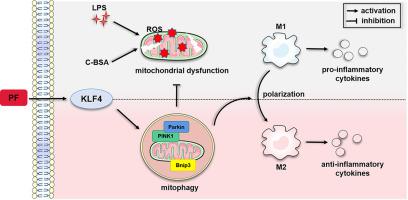Phytomedicine ( IF 6.7 ) Pub Date : 2023-05-24 , DOI: 10.1016/j.phymed.2023.154901 Yiwen Cao 1 , Jingli Xiong 1 , Xueping Guan 1 , Simin Yin 1 , Junqi Chen 1 , Shengliang Yuan 1 , Hong Liu 1 , Shuyin Lin 1 , Yuan Zhou 1 , Jianguang Qiu 2 , Dejuan Wang 2 , Bihao Liu 2 , Jiuyao Zhou 1

|
Background
Macrophages M1 polarization involved in the process of renal inflammatory injury, is a well-established hallmark of chronic kidney disease (CKD). Paeoniflorin (PF), a water-soluble monoterpene glycoside extracted from Paeonia lactiflora, revealed renal anti-inflammatory activities in our previous study. However, the potential molecular mechanism of PF on CKD remains unknown.
Purpose
The present study aims to investigate the regulation of PF on macrophage polarization in CKD.
Methods
A CKD model was established by cationic bovine serum albumin and a murine macrophage cell line RAW264.7 induced with lipopolysaccharide (LPS) were used to clarify the underlying mechanisms of PF in CKD.
Results
Results showed that PF exhibited favorable protective effects on CKD model mice by promoting renal function, ameliorating renal pathological injury and podocyte damage. Furthermore, PF inhibited the infiltration of M1 macrophage marker CD68 and iNOS in kidney tissue, but increased the proportion of M2 macrophage marker CD206. In RAW264.7 cells stimulated with LPS, the levels of cytokines including IL-6, IL-1β, TNF-α, MCP-1 were lessened under PF treatment, while the levels of Arg1, Fizz1, IL-10 and Ym-1 were augmented. These results indicated that PF promoted macrophage polarization from M1 to M2 in vivo and in vitro. More importantly, PF repaired the damaged mitochondria through increasing mitochondrial membrane potential and reducing ROS accumulation. The mitophagy-related proteins PINK1, Parkin, Bnip3, P62 and LC3 were up-regulated by PF, accompanied by the incremental expressions of Krüppel-like transcription factor 4 (KLF4). Moreover, the promotion of mitophagy and inhibition of M1 macrophage polarization owing to PF were reversed by mitophagy inhibitor Mdivi-1 or silencing KLF4.
Conclusion
Overall, PF suppressed renal inflammation by promoting macrophage polarization from M1 to M2 and inducing mitophagy via regulating KLF4. It is expected to provide a new strategy for exploring the effects of PF in treating CKD.
中文翻译:

芍药苷通过 KLF4 介导的线粒体自噬调节巨噬细胞极化来抑制肾脏炎症
背景
巨噬细胞 M1 极化参与肾脏炎症损伤过程,是慢性肾脏病 (CKD) 的一个公认标志。芍药苷 (PF) 是一种从芍药中提取的水溶性单萜糖苷,在我们之前的研究中揭示了肾脏抗炎活性。然而,PF对CKD的潜在分子机制仍不清楚。
目的
本研究旨在探讨 PF 对 CKD 巨噬细胞极化的调节作用。
方法
采用阳离子牛血清白蛋白建立CKD模型,并利用脂多糖(LPS)诱导的小鼠巨噬细胞系RAW264.7阐明PF在CKD中的潜在机制。
结果
结果表明,PF对CKD模型小鼠具有促进肾功能、改善肾脏病理损伤和足细胞损伤的良好保护作用。此外,PF抑制肾组织中M1型巨噬细胞标志物CD68和iNOS的浸润,但增加了M2型巨噬细胞标志物CD206的比例。 LPS刺激的RAW264.7细胞中,PF处理后IL-6、IL-1β、TNF-α、MCP-1等细胞因子水平降低,而Arg1、Fizz1、IL-10和Ym-1水平降低。被增强了。这些结果表明,PF在体内和体外均促进巨噬细胞从M1向M2极化。更重要的是,PF通过增加线粒体膜电位和减少ROS积累来修复受损的线粒体。线粒体自噬相关蛋白 PINK1、Parkin、Bnip3、P62 和 LC3 被 PF 上调,同时 Krüppel 样转录因子 4 (KLF4) 的表达增加。此外,PF 导致的线粒体自噬的促进和 M1 巨噬细胞极化的抑制可被线粒体自噬抑制剂 Mdivi-1 或沉默 KLF4 逆转。
结论
总体而言,PF 通过促进巨噬细胞从 M1 极化到 M2 并通过调节 KLF4 诱导线粒体自噬来抑制肾脏炎症。有望为探索PF治疗CKD的作用提供新策略。











































 京公网安备 11010802027423号
京公网安备 11010802027423号